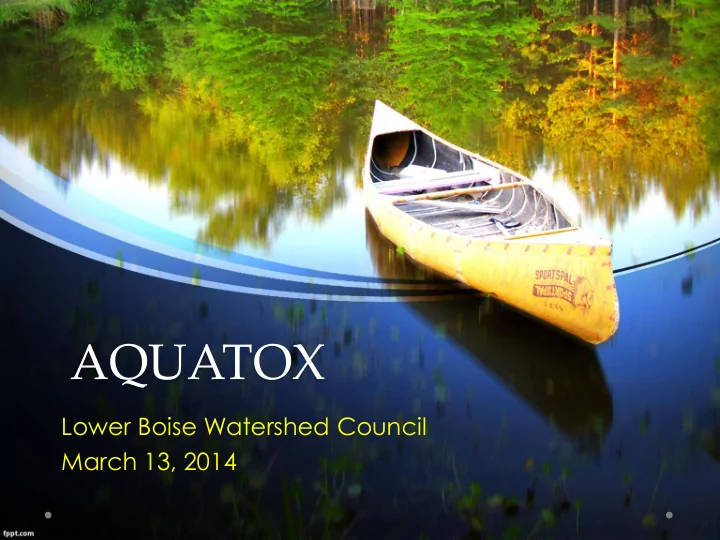

AQUATOX Lower Boise Watershed Council March 13, 2014
Why Use a Water Quality Model? • Complex correlation between nutrients and eutrophication response in rivers • Models are useful tools for TMDL and numeric nutrient criteria development • Can understand causal relationships and conduct what-if scenarios
What is a Water Quality Model? • A model is a tool for describing and understanding our environment. • Water quality models are tools for simulating increased/decreased pollutants and the associated water quality impacts. “Essentially all models are wrong, but some are useful” (George E. Box)
Modeling TAC Modeling TAC meetings were facilitated by Troy • Smith – DEQ Group met 11/28/2012 – present • 4 initial planning meetings and 31 model work meetings o Decision process – group discussions with final • decisions made by DEQ. Model was calibrated by Darcy Sharp – DEQ • DEQ Documentation • Meeting agendas o Meeting summaries (decisions, presentations, action items) o Model Calibration Comment Log (113) o Model Decision Log o Model Report o
Modeling TAC Core Group Consultants Troy Smith – IDEQ • Jonathan Clough – Warren • Darcy Sharp – IDEQ • Pinnacle Consulting Ben Cope – EPA • Richard Park – Eco • Bill Stewart – EPA • Modeling Tom Dupuis – HDR • Michael Kasch – HDR • Matt Gregg – Brown and Additional Assistance • Caldwell Alex Etheridge, Dorene • Jack Harrison – HyQual • MacCoy, Chris Mebane – Lee Van de Bogart – • USGS Caldwell • Clifton Bell – Brown and • Robbin Finch – Boise • Caldwell Kate Harris – Boise •
Modeling TAC Process Determined performance requirements for • water quality model Evaluated multiple models • Chose water quality model • Gathered data and/or collected more • Chose variables to minimize complexity • Set calibration goals (AME) • Divided model into reaches • Reviewed initial conditions for each segment • Determined how to incorporate groundwater • Reviewed process equation parameters • Reviewed initial and updated versions of the • model during the calibration process
Why AQUATOX? • IDEQ Calibration Report – page 4 • Models effects of pollutants on organisms • Best suited to LBR TMDL needs – periphyton • Model developers assisted in LBR set up and calibration • AQUATOX in EPA’s suite of recommended models
What is Model Calibration? Calibration is the adjustment of model parameters and constants to improve the agreement between model output and observed conditions Sensitivity analyses – Monte Carlo simulations
AQUATOX Model • Thirteen segments • Diversion Dam to Parma • Average reach ~ 5 miles/reach • Simplified • Fish and macroinvertebrates “turned off” • Initial run: Single Algal species • Assumes well mixed condition • Inputs/withdrawals for reach averaged
Limitation Solution AQUATOX is not: Hydrodynamic Extensive water balance work model external to AQUATOX; depth discharge spreadsheet developed; modeled vs. observed velocities compared Temperature model Used observed temperature data and interpolated or used curve fitting analyses for missing data points AQUATOX does not: Model groundwater The “unaccounted for flow” was apportioned between segments 10- 13. Q and C interpolated. Include stormwater TBD AQUATOX did not: Have data for all 13 Some data was used for multiple segments segments (temperature, dynamic depth, etc.). DEQ did extensive analyses to establish appropriate initial conditions for each segment.
How Do We Know it is Useful? Model was “realistic” • o Similar Modeled and Actual Algal Community o Similar Modeled and Observed Results Calibration analyses • o Outperformed AME goals established by TAC o Positive correlations between monthly simulations and historical data as well as between monthly simulations and measured data (except segment 1). Extensive review by model developers and • Modeling TAC members
Recommendation: The Modeling Workgroup and TAC recommend WAG approval of the calibrated AQUATOX model for use in development of the Lower Boise River Total Phosphorus TMDL
How Does AQUATOX Model Water Quality? • Mechanistic model • Requires input data Driving variables (water temperature, pH and TSS) o State variables (total ammonia as N, nitrate as N, total soluble o P; CO 2, dissolved oxygen; buried, sediment, and water column refractory and labile detritus; periphyton [low and high nutrient diatoms, blue green, Cladophora, green], phytoplankton (green, bluegreen, high and low nutrient diatoms])
Algal parameters • Optimal temperature • Maximum temperature • Temperature response slope • Saturating Light • Maximum photosynthetic rate • Light extinction coefficient • P half saturation constant • N half saturation constant • Inorganic C half saturation constant • Exponential mortality coefficient • Critical force for periphyton scour • Percent periphyton lost in slough event
Recommend
More recommend